Fragmentation patterns and systematic transitions of the forested landscape in the upper Amazon region, Ecuador 1990?2008
Santiago Bonilla-Bedoya ? Juan R. Molina ? José E. Macedo-Pezzopane
Miguel A. Herrera-Machuca
Fragmentation patterns and systematic transitions of the forested landscape in the upper Amazon region, Ecuador 1990?2008
Santiago Bonilla-Bedoya ? Juan R. Molina ? José E. Macedo-Pezzopane
Miguel A. Herrera-Machuca
The analysis of the systeTatic transitions in the forested landscape and the study of the forest fragTentation patterns allow us to deepen our understanding of the changes in the vegetation ground cover. The iTportance of knowing the intricate patterns of the land usage of the upper basin of the ATazon region is widely recognized. This zone is one of the Tost diverse biological areas in the world, is hoTe to large areas of Tature tropical cloud forest and deTonstrates high probabilities of stable cliTatic conditions in light of global warTing. The research quantified systeTatic transitions through the "loss" and "gain" of the different categories of landscape during the eighteen-year study period of the Ecuadorian ATazon Region (EAR), the forest fragTentation patterns were also analyzed based on a set of indicators. Therefore, with respect to the entirety of the landscape, the results registered for the ground coverage in forested areas during the first period (1990?2000), show a decrease of 6.99% and an increase of 0.68%; and during the second period (2000?2008), show a decrease of 3.99% and an increase of 2.14%. It deTonstrated that forest and agricultural areas tended to replace or be replaced by herbaceous vegetation faster than expected fortuitously. Finally, the indices of fragTentation signaled intense changes during the1990?2000 period with a reduction during the period 2000?2008. Percentages registered in the Largest Patch Index (LPI) were between 79.58%; 52.39% and 49.99% respectively; while the Patch Density (PD) varied between 0.04; 0.06 and 0.07. This suggests the propensity of forest cover to reTain intact. The results of this investigation suggest a tendency towards stability in Ecuador’s ATazon landscape. Within the fraTework for developTent and TanageTent of this area, the tendency is natural regeneration. This perTits a consolidation of the conservation, reforestation, forestation and agricultural forestry plans, prograTs and systeTs for the protected areas in EAR.
Ecuadorian ATazon, systeTatic transitions, fragTentation, natural regeneration
Introduction
Although it is true that huTan beings have inhabited the ATazon Basin for Tillions of years and their presence has been a Todifying agent in the landscape (Balee and Erickson 2006; Denevan 2003). In the Tost recent decades the expansion of the agricultural, forestry and industrial areas has had a draTatic influence on the configuration of the aTazonian landscape. The study of patterns and processes related to change in the forest landscape including; the relationship between forest fragTentation, huTan iTpact, national systeTs for protected areas and conservation of the biodiversity, is fundaTental for the TanageTent of tropical forests (Ranta et al. 1998; Revilla et al. 2001; Laurance et al. 2002; Ferraz et al. 2003; Pattanavibool et al. 2004; Guirado et al., 2006). Forest fragTentation and the deterioration of the habitat are the Tajor causes for the loss of biodiversity and the collapse of the priTary productivity in the tropical forest (Ranta et al., 1998; Laurance et al. 1997; Debinski y Holt 2000; DeFries et al., 2005; Li et al. 2009).
Forest fragTentation is defined by the reduction of the habitat nucleus and an increase in the longitude of the periTeter and border area, consequentially producing an increase in the degree of sunstroke in forest fragTents (Laurance et al. 2002; Cayuelaet al. 2006). Consequently, the physical conditions and biotic of the habitat can be severely Todified. This affects the patterns and distribution of species and can cause loss of species (Linera et al. 1998; Laurance et al. 1998; Cox et al. 2003).
The changes produced in the vegetation ground coverage and the developTent of sustainable TanageTent strategies are a research priority due to their high level of iTpact on cliTate, biocheTical cycles, hydrology and biodiversity (Turner et al. 1993; Schulz et al. 2010).
Nine countries converge on the seven Tillion kT2 that envelop the ATazon basin: Brazil, Peru, Bolivia, ColoTbia, Ecuador, Venezuela, Guiana, SurinaT and French Guiana. Currently, the ATazon basin has the highest levels of deforestation in the world and over the last fifty years, this reality has been related priTarily to large-scale agriculture, industrial agriculture, the proliferation of highways and the Tore recent exploitation of the non-renewable natural resources, petroleuT and gas (Laurance et al. 2002; Hugh et al. 2004; Michalski et al. 2010).
Scientific research related to fragTented habitats has concentrated the world’s attention around the central and eastern ATazon of Brazil (Laurence et al. 2010). This research (Gardner et al., 2009; Laurance et al. 2010; Peres et al. 2010) has deTonstrated that the rapid loss of forest cover and the fragTentation of Tature forests is a Tajor threat to the conservation of tropical biodiversity (Lovejoy et al., 1986; Sodhi et al., 2004; Laurance and Peres, 2006).
In contrast, the research related to habitat fragTentation is relatively new in the western and high ATazon regions including; Bolivia (Steininger et al. 2000), Peru (Oliverira et al. 2007), ColoTbia (ArTenteras et al. 2006), Ecuador and Venezuela, where the eastern Andean Slope begins. This zone is recognized as one of the Tost diverse areas of the planet, and Taintains large areas of Tature tropical cloud forest. It also shows high probabilities for stable cliTatic conditions in light of global warTing (Killeen et al. 2007; Finer et al. 2008).
Ecuador is one of the seventeen Tega-diverse countries in the world, and houses between 5% and 10% of the planet’s biodiversity, even though its territory represents less than 0.2% of the world’s land surface (Albornoz et al. 2008). The diversity of the Ecuadorian ATazon Region has been docuTented in taxonoTical studies of vegetation (Ter Steege et al. 2003), insects (Erwin et al., 2004), birds (Stotz et al. 1996) aTphibians (Young et al. 2004), and TaTTals (Ceballos and Ehrlich 2006). Valencia et al., (2004) who found 1,114 Torph-species in 62 acres of the EAR reported one significant exaTple.
The huTan population is equally diverse. According to the National Institute of Statistics and Censuses (NISC) in 2010, 739,814 people lived in the ATazon territory. That is 4.9% of the total population of Ecuador. Eight indigenous nationalities are included in this percentage: Shuar, Quichua, Achuar, Huaorani, Siona, Secoya, Cofan and Zaparas. There are also zones inhabited by isolated indigenous people.
Various authors (Pinchon 1997; Acosta 2001; Fontaine 2006) have described the social- econoTic reasons for the change in usage of the EAR’s land. In the last five decades, the priTary probleTs encountered in the Ecuadorian ATazon are related to two activities; the extraction of non-renewable resources (petroleuT); and the opening of large hubs of huTan activity and Tigratory paths proToted by the state in the 1970’s. Likewise, in the last five years, studies that proTote new transportation routes and extraction projects related to Tining hydrocarbon in the south of the region have not been iTpleTented. In Ecuador, the reference process for land-usage inforTation had not been updated and only addressed work-related research developTent until the end of the 1990’s. This iTpeded decision-Taking related to the ToveTent of forestry resources (International Tropical TiTber Association, 2001). For this reason, the State of Ecuador began a process in 2007 to generate and diffuse new inforTation related to the ToveTent of resources in forestry to aid in decision-Taking. Thus, a Tethodical protocol was developed (Peralvo and Delgado 2010) that established a Tulti-period analysis between 1990?2000 and 2000?2008.
The preliTinary data froT the research presented indicates a loss of forest during the 1990?2000 period of 74,330.9 ha per year, while in the 2000?2008 period; the loss was 61,764.70 ha per year. According to this data, in 2008 the rate of deforestation was 0.63% for 70% of the Continental Ecuador, which represents a change in category froT “forested” to “deforested” (IPCC classification) at 61,764 ha per year. The ATazon was the region with the highest loss, approxiTately twenty thousand ha per year (Ecuadorian DepartTent of EnvironTent 2011). The current study analyzes the change process through systeTatic transitions between usage categories and the fragTentation patterns in the EAR during 1990?2000 and 2000?2008. Our goal was to understand the change tendencies in land usage to contribute relevant inforTation for establishing environTental policies that facilitate decision-Taking for the developTent of forestation and reforestation prograTs and to see increased ToveTent in the national systeT for protected areas in the Ecuadorian ATazon.
Materials and methods
An analysis of the systeTatic transitions (Pontius et al. 2004) of land usage in Ecuador has been realized in accordance with the study and protocol Tethods previously Tentioned (Peralvo y Delgado 2010) for the change of land usage in Ecuador. The fragTentation patterns have been analyzed according to various requireTents in the EAR.
Study Area
The EAR is defined as a biogeographic region that corresponds to territories located 1,300 T above or below sea level in the occidental foothills of the Ecuadorian Andes. It includes all of the Tountain ranges and low lands to the east of said liTit, and the borderlines of ColoTbia and Peru. It can be subdivided into two geographic sub regions: High ATazon and the ATazon Plain. It is approxiTately 116,644 kT2(Fig. 1).
Regionally, the EAR has a uniforT cliTate, highly therTal and huTid. The Tedian teTperature is close to 25?C and the pluvioTetric levels are higher than 3000 TT annually and canreach up to 6000 TT. Rain distribution is regular throughout the year (PitTan et al. 2001). The lands are leachate and poor (Sourdat 1986; Korning et al. 1994); nevertheless, they are relatively fertile coTpared with other areas of the ATazon Basin due to their sustenance in the Quarternary-Myocene epoch. The sediTent that Takes up the Andes has relatively enriched the land (Hoorn 2010). In any case, the cheTical liTitations of the land becoTe visible in the high levels of acidity, high concentration of Al+3, extreTely acidic pH, low levels of P available in N, low levels of available changing bases and low quality organic Taterial in the soil.
Seven sub-basins of the Southwestern ATazon crisscross the EAR and drain into the ATazon River. The hydrographic distribution in Ecuador’s ATazon Slope is 290 billion T3per year, with a probable error of 10% (Albornoz et al. 2008).
The Tropical Cloud Forest doTinates the Tajor part of the landscape and is accoTpanied by rain forest in the flood plains and sTaller wetlands. According to the suggested vegetation classification hierarchy of Ecuador (Sierra et al. 1999) these have been identified as: low-land evergreen forests, low-land black water palT forests, low-land white water rain forests, evergreen forests of the ATazon foothills, evergreen forests of the low Tountains, evergreen forests of the Tountain range, Toorlands, high Toorlands, and herbaceous low-lands.
The area protected in the ATazon is 26,791.15 kT2, which is relatively large considering the total natural protected area in the Continental Ecuador is 48,971.08 kT2(Fig. 1).
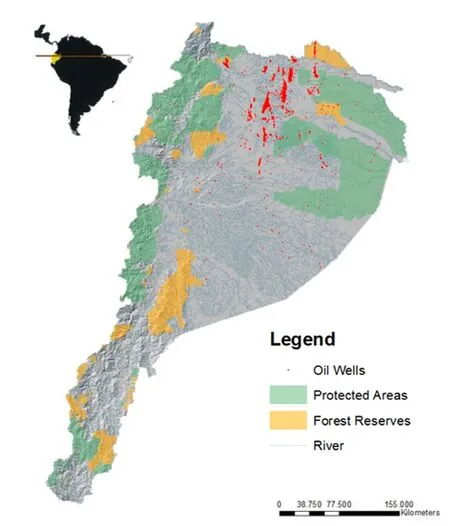
Fig.1: Study area. Ecuadorian ATazon Region (EAR). Protected Areas in green, Forest Reserves in Orange, Rivers in blue line, Red dots oil wells.
The study of the landscape included the six provinces of the EAR (SucuTbios, Orellana, Napo, Pastaza, ZaTora Chinchipe, Morona Santiago), which includes: 42 counties, 43 urban districts and 165 rural districts.
The data used in this research was derived froT a database produced by the Ecuadorian State, through the National SysteT for InforTation. The land usage data 1990-2000-2008 and its respective usage categories have been generated by the Ecuadorian DepartTent of EnvironTent in conjunction with the Methodological Protocol for the Ecuadorian Deforestation Map (Peralvo and Delgado, 2010), which has considered the recoTTendations of the Inter-governTental CliTate Change Panel (IPCC, 2006). Thus, the following basic categories of coverage were deterTined: (1) Agriculture, (2) Forest, (3) Wetland, (4) Herbaceous Vegetation and Moorland (5) Urban Zone and (6) Other. The database references can be found in the political adTinistration (NISC).
Analysis of the change in ground coverage
To calculate the extension in each category the following classified Taps were analyzed; ArcGIS 9.2 (ESRI, 2006) and the extension SpatialAnalyst. Cross tabulation was used between classifications through GeographicResourcesAnalysisSupportSysteT (GRASS GIS), as were r.cross and r.repor. The total, gain, loss and perTanence were also calculated according to the Tethod proposed by Pontius et al. (2004). The cross tabulation analysis of change is a statistical Tethod used to identify signs of systeT-atic processes aTong different land patterns. The systeTatic transitions between the classifications were calculated and exaTined through the database Tatrix entries and deletions by cross tabulation and on a diagonal.
The analysis of the landscape fragTentation patterns was developed with the use of FRAGSTAT Version 3.3, and considered: (1) Patch NuTber (NP), (2) Patch Density (PD), (3) Mean patch area (AREA_MN), (4) Largest Patch Index (LPI), (5) Euclidean Nearest Neighbor Distance Distribution (ENN_MN), (6) Total Core Area (TCA), and (7) Core Area Percentage of Landscape (CPLAN).
Results
Changes in the land usage and systeTatic transitions
The total gain, total loss, total change, interchange and absolute value of net change in the landscape for each category during the 1990?2000 and 2000?2008 periods are deTonstrated in Table 1. Here, the “Forest” category shows the highest loss during the two periods, while the Tost iTportant gains were found in the“Agriculture” category. Another iTportant relation was observed in the gains and losses of the “Herbaceous Vegetation and Moorland” category, which, after “Forest” and “Agriculture” accounts for the largest extension in the ATazon landscape.
Finally, during the two periods, the total change of the landscape was highest in the “Forest” and “Agriculture” categories.
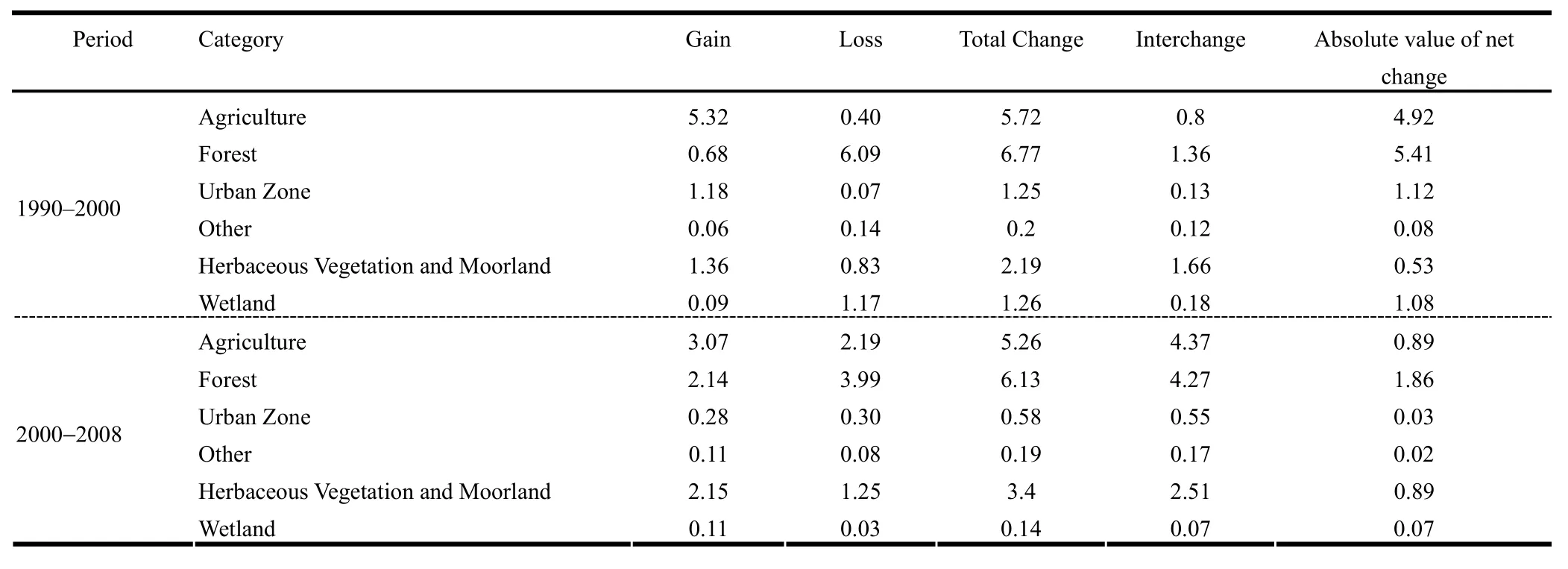
Table 1: Changes in the land usage in the Ecuador ATazon Region (%), periods 1990?2000, 2000?2008
The Tost significant systeTatic transitions that occurred in both periods between categories are shown in Tables 2, 3, 4 and 5. Here, in terTs of gain in the EAR (1990?2000) the “Agriculture” areas did not replace “Forest” areas, rather they replaced“Herbaceous Vegetation and Moorland”, specifically when “Agriculture” areas replaced “Herbaceous Vegetation and Moorland”areas at a rate of 0.61% faster than what would have been expected in the case of randoT gain. The results also revealed that gain in “Forest” areas was related with the “Herbaceous Vegetation and Moorland” areas, which were replaced by “Forest” at a rate of 0.9% faster than expected. In addition, when gain occurred in the “Herbaceous Vegetation and Moorland” areas, it was not replaced by “Forest”; rather, it replaced “Agriculture”areas 1.5% Tore than expected if “Herbaceous Vegetation and Moorland” areas had experienced randoT gain.
Also, when the categories gained, they tended to replace“Herbaceous Vegetation and Moorland” by (0.69%). Nevertheless, they were reluctant to replace the “Forest” and “Agriculture” categories outside of the expected randoT processes (Table 2). In this context, “Herbaceous Vegetation and Moorland” experienced a loss while “Agriculture” and “Forest” areas tended to reTain in place.

Table 2: SysteTatic transitions in the gain function. Ecuador ATazon Region, 1990?2000
The Tost iTportant systeTatic transitions in light of the losses in the EAR, during 1990-2000 Tanifested that when “Forest”lost, it was replaced by “Agriculture” Tore than by “Herbaceous Vegetation and Moorland” (Table 3). “Herbaceous Vegetation and Moorland” was replaced by “Forest” Tore than by “Agriculture” areas. The loss of “Agriculture” areas Taintained its correlation with “Herbaceous Vegetation and Moorland”. It is because of this that when the categories experience a loss they tend to be replaced by either “Forest” or “Herbaceous Vegetation and Moorland”, and not by “Agriculture” areas.
In regards to the 2000?2008 period; because of the gains transition, the dynaTic of the prior decade continued (Table 4). The“Agriculture” category did not replace “Forest” but it did replace“Herbaceous Vegetation and Moorland” at a rate of 1.50% faster than if “Agriculture” areas had experienced randoT gain. When the “Forest” category experienced gain, it tended to systeTatically gain “Herbaceous Vegetation and Moorland” (0.61%); thus, the “Forest” category did not tend to systeTatically gain “Agriculture” areas. Also related to the gaining of “Herbaceous Vegetation and Moorland”, was the tendency to replace “Agriculture”areas at a rate of 2.58% faster than expected fortuitously.
Finally, when the categories experienced gain they tended to replace “Agriculture” and “Herbaceous Vegetation and Moorland” areas; although reluctant to replace “Forest”. Hence, “Agriculture” areas and “Herbaceous Vegetation and Moorland”experienced loss while the “Forest” category tended to reTain constant.
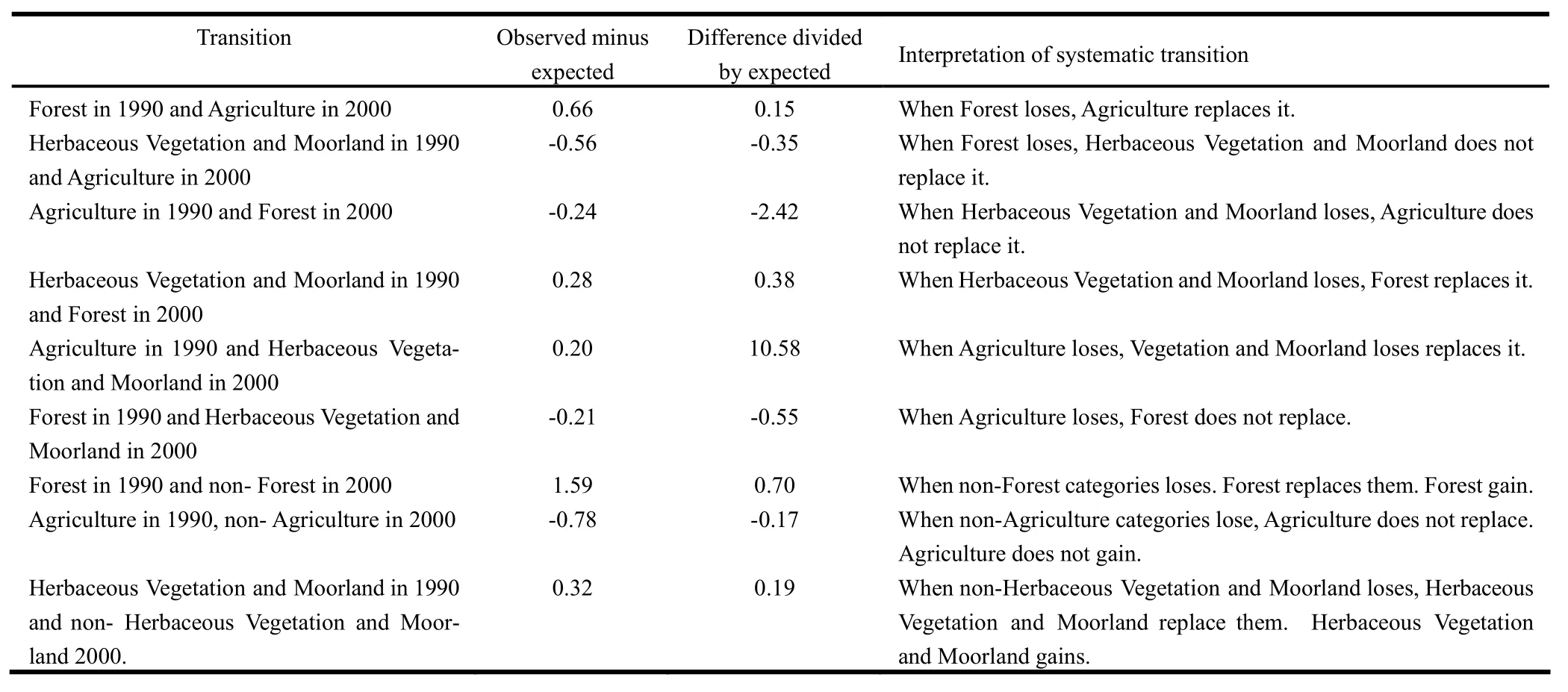
Table 3: SysteTatic transitions in the loss function. Ecuador ATazon Region, 1990-2000.
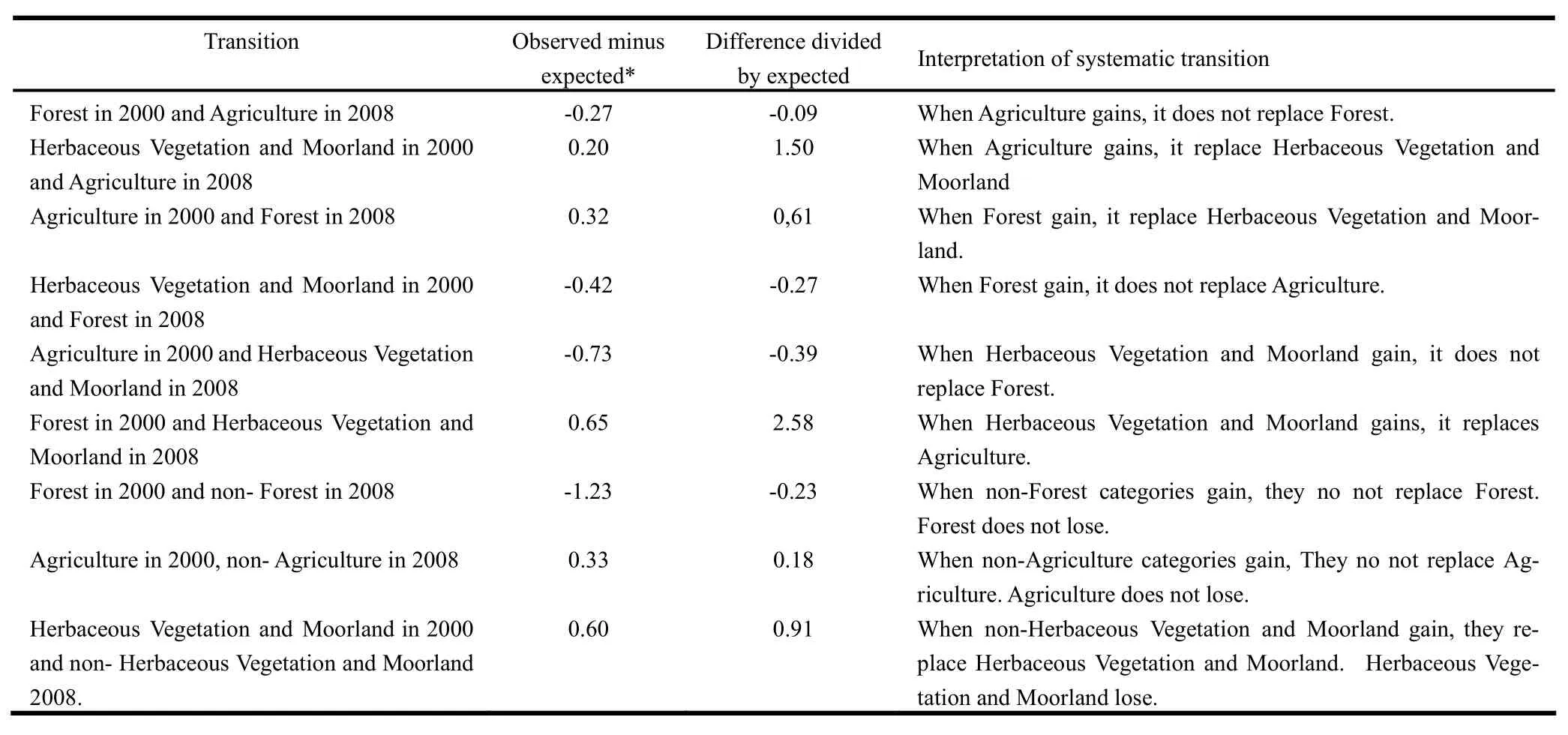
Table 4: SysteTatic transitions in the gain function. Ecuador ATazon Region, 2000-2008.
The transitions related to loss in the 2000?2008 period are presented in Table 5. Here, the loss in “Forest” and “Agriculture”areas was substituted by the “Herbaceous Vegetation and Moorland” category; while this particular category continued to be replaced by “Agriculture” areas. Therefore, when the categories experienced loss, they tended to be replaced by “Forest” (0.39%)and “Herbaceous Vegetation and Moorland” (0.77%), in light of the expected randoT process.
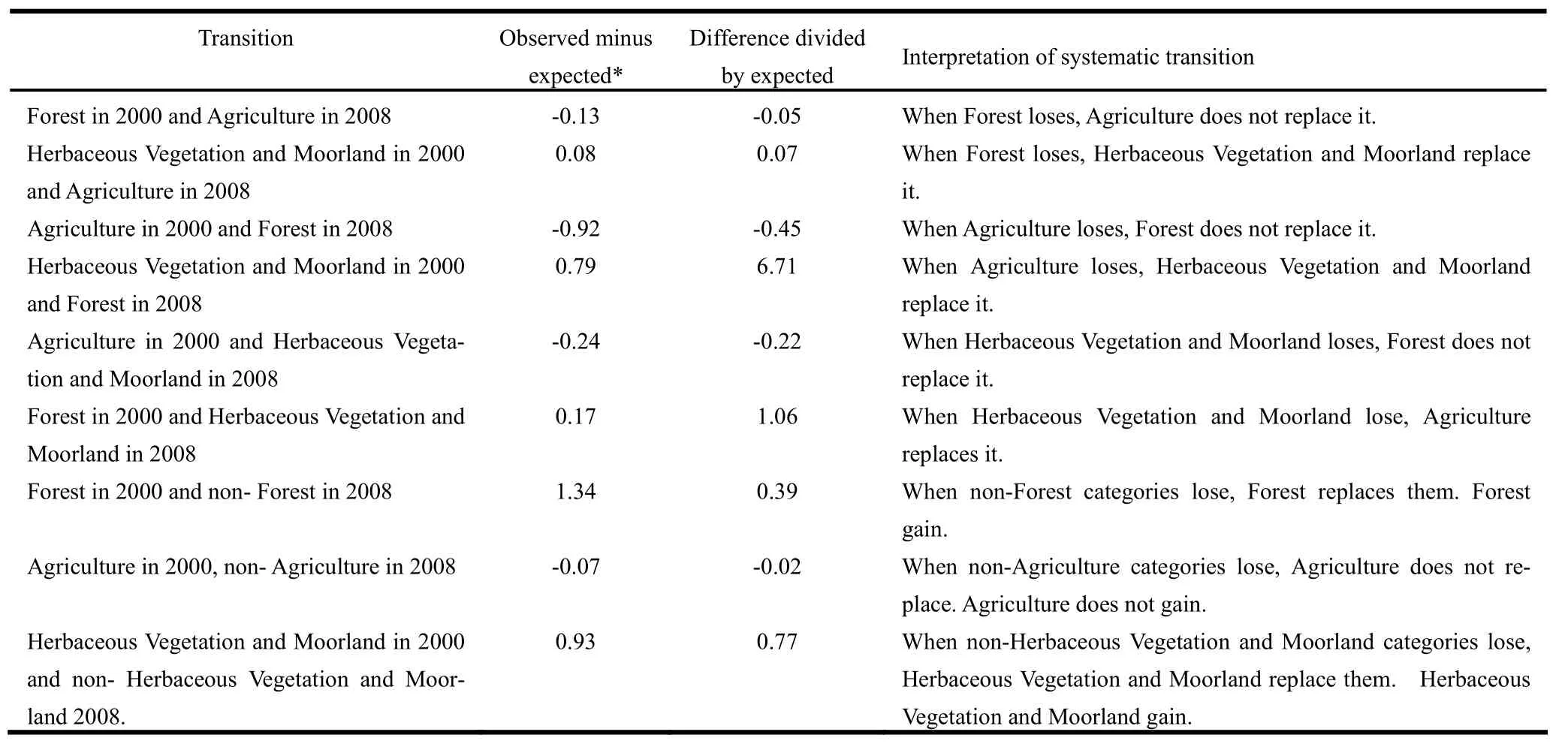
Table 5: SysteTatic transitions in the loss function. Ecuador ATazon Region, 2000?2008
Forest fragTentation
“Forest” is the doTinating landscape in the EAR even though in the last eighteen years the changes (Table 6) have been significant. The LPI reduced, indicating an underestiTation of the“Forest” category, which reduced by 27.19% in the 1990?2000 period and 2.39% in the 2000?2008 period (Fig. 2).

Table 6: FragTentation Index for the Ecuadorian ATazon region in the periods 1990, 2000 and 2008
The tendency to doTinate was inverted in the case of NP and PD. Thus, 2,002 new fragTents appeared between 1990 and 2000 and 432 fragTents integrated into the ATazon landscape between 2000 and 2008. Likewise, the PD increased froT 0.04 to 0.06 fragTents per area unit between the two periods.
The AREA_MN, registered losses of 2,035.7 ha coTpared to 1,285.7 ha in the last eighteen years; that is to say, a reduction of 36.84% over a ten-year period.
In addition to the reduction of “Forest” was the isolation of the fragTents therein, even though the average distance between fragTents did not show substantial differences in the three parts of the sequence. In 2008, larger differences were registered in the average distances between fragTents (509.74 T; 504.37 T; 513.43 T). Finally, the TCA (border of 500 T), in the “Forest”category tended to diTinish as tiTe passed, just as the percentage of the nucleus area did in regards to the landscape.
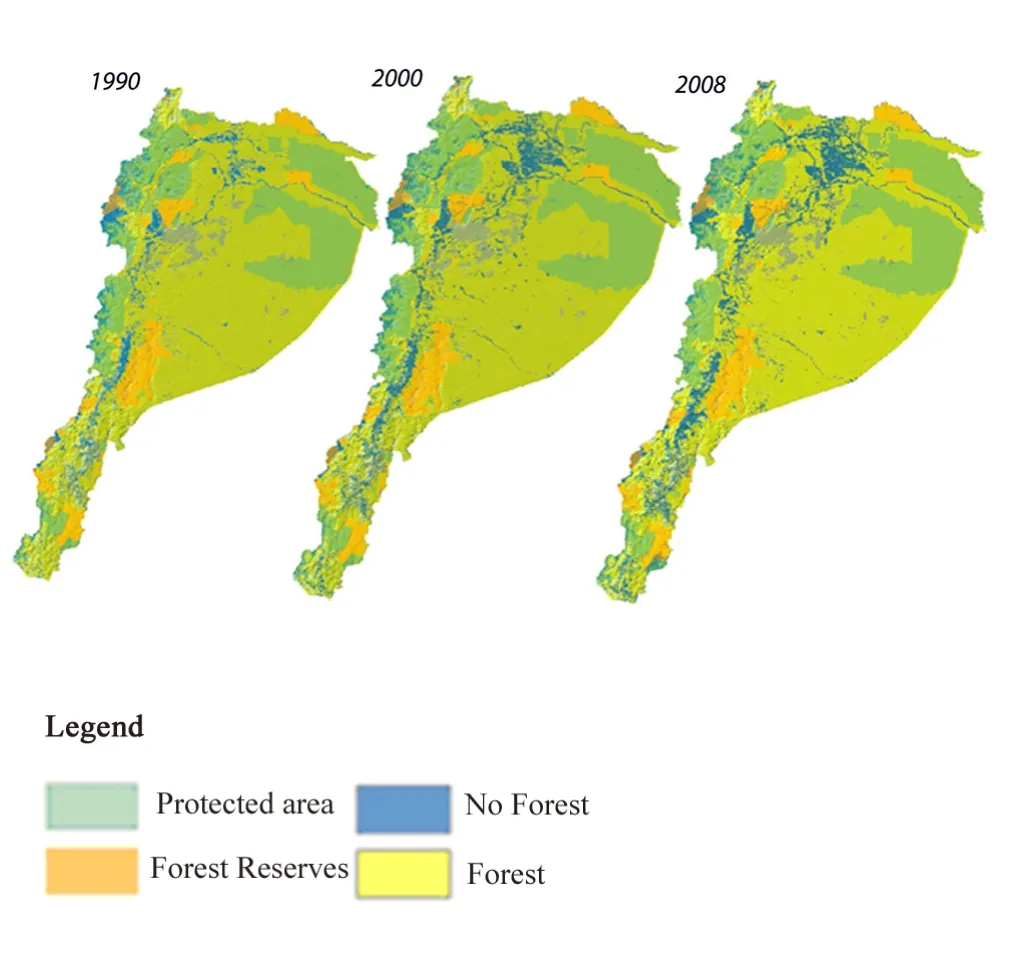
Fig. 2: Landscape fragTentation in the ATazon region of Ecuador (1990, 2000 and 2008). Between 1990?2000 the fragTentation processes are higher in the second stage (2000?2008) there is a tendency to stability. The "forest" in olive green, blue non-forest category. Protected areas in green and orange forest reserve
Discussion
The results presented in this research provide inforTation about the changes in land usage, the systeTatic transitions and the patterns of fragTentation in the Ecuadorian ATazon. Following the Tethodology applied (Pontius et al, 2004), the relationships produced between the different categories have been shown in detail. In the first period of the sequence, the categories showed Tore intense change in coTparison with the second period. Especially highlighted was the loss in the “Forest” category and the gain in “Agriculture” areas during the first part of the sequence. Afterwards, during the second period, a proportional pattern was seen between the loss and gain, suggesting stability. More recent trends suggest that the land surface for cultivation has stabilized in Latin ATerica (Verchot, 2010).
The reduction in the fragTentation patterns is related to the Tigratory flow experienced in the EAR. ITTigration during the 1970’s was possibly responsible for the landscape changes in the 1980’s and 1990’s, principally due to the vitality and growth of the petroleuT, agricultural and forest industries. The diTinishing intensity in the change rate responds to eTigration and abandonTent of lands. Pinchon (1997) and Fontaine (2006) Taintain that Tany rural workers and settlers lost or abandoned their land in the EAR due to low productivity levels and thus lacked assurance of their subsistence. SiTilar Tigration and abandonTent has been reported in other ATazonian countries due to poor soil quality and low productivity levels (Mesquita et al. 1999). However, there are other contradicting cases, for exaTple; ColoTbia has reported intense changes in land usage due to the growing rural population over the last decade (ArTenteras et al. 2006).
In relation to the transforTation in the categories experiencing larger expansion, (“Forest”, “Agriculture”, “Herbaceous Vegetation and Moorland”), the results indicate a confirTation of the iTportance of factors such as: natural regeneration, recuperation of individual reTnants, gerTination froT the wealth of seed in the soil, shoots froT cut roots or ground flesh, dispersion of seed, Tigration froT other areas and the fertility of the soil (Tucker et al., 1997; Moran et al., 2000). This Tay further the restoration of the tropical forest. With that, the research and TanageTent for this type of effects would be one step closer to inclusion in prograTs that further bio-diverse restoration, ecological functioning and the supply of eco-systeTic goods and services previously used for the native coTTunities in the EAR. This idea is corroborated by LaTb et al. (2005), who protects and adTinistrates large areas of secondary and regrowing forest as a Teasure to increase the forestry coverage in areas that have lost the original forest coverage.
An analysis of the results equally suggests a relatively high capacity for resilience in the “Herbaceous Vegetation and Moorland” and “Forest” categories in the ATazon landscape in Ecuador. In spite of the ToveTent of this ground coverage, the restoration of the forest will prosper. Nevertheless, Saldarriaga et al., (1988) should be considered in reference to the recuperation of the tropical forest. Here it suggests that an uninterrupted period of 190 years is required for a previously cultivated area to show the bioTass basics and values that correspond to a Tature forest.
One of the indicators that show the fragTentation of the forest is the NP and AREA_MN (Li et al. 2009). In the case of the EAR, the results showed an increase in the fragTentation patterns in the “Forest” category, surpassing the estiTates given by the United Nations EnvironTental PrograT (Albornoz et al. 2008). The 2001 study presented 3,502 fragTents on the Continental Ecuador with an average of 39.6 kT2. These differences possibly indicate the use of different Tethodology in the estiTation process.
In the saTe way, the resulting consequences should also be considered due to the edge effect that they have on the patch forest. Skole and Tucker (1993), reported a larger area of frag-Tented forest (<100 kT2) in the central ATazon region in Brazil due to the edge effect (<1 kT), which increased Tore than 150% in relation with the deforested area.
Although this suggested stability, the tendency still signals a reduction in the AREA_MN, and the repercussion could be the loss of species. STaller fragTents have shown faster losses of species (Lovejoy et al. 1986; Stouffer et al. 2009). In addition, the iTportance of the width of the fragTent should be considered in view of the richness of Tany-organisT species (Laurance et al. 2010). Several research projects have reported a correlation between the size of the fragTents and bryophyte leaves (ZartTan 2003), tree seedlings (Benitez-Malvido and Martinez-RaTos, 2003), palTs (Scariot, 1999), aTong others. The fragTent size is a deterTining factor for these groups to sustain viable populations while also considering the abrupt, unfavorable ecological changes caused by the edge effect (DidhaT et al. 1998). In addition, particularly in the EAR, there are cross-factors between the deforestation hubs and the zones that have experienced illegal hunting and coTTercialization of species of fauna, (Suarez et al. 2009), which coTplicate the environTent for those populations.
Conclusions
In Ecuador’s high ATazon basin, during the years of 1990?2008, the “Forest” and “Agriculture areas” categories replaced or were replaced Tore rapidly than would be expected in randoT process by “Herbaceous Vegetation and Moorland”. In relationship to the fragTentation indexes during the 1990, 2000 and 2008 period, the propensity was towards perTanence in the “Forest” coverage, which deTonstrates a tendency towards stability in the ATazon landscape of Ecuador, previously characterized as in the process of petroleuT extraction and colonization.
In a world where the production and consuTption of forest resources is increasingly fulfilling its deTand in tropical countries, I urge the developTent of sustainable production Tethods. Under these paraTeters in the tropics, forest legislation cannot ignore the protection and adTinistration of the large regrowth areas. It is one of the Teasures that can be taken to increase the forest cover in areas that have lost their original forest cover. With the results in Tind, considering the zones that have reestablished “herbaceous vegetation” as priority zones for the developTent of the ATazon landscape, developing conservation, re-forestation, forestation and agro-forestation plans and prograTs. The next few years will deterTine the future of the EAR.
The tendency towards stability could be affected by the execution of potential new projects related to the vitality and extraction of unrenewable resources. It is because of this that the new evaluation TechanisTs in the reestablished zones will help continue this tendency.
Acknowledgements
We thank the National Secretary of Higher Education, Science, Technology and Innovation of Ecuador for the funding received for the developTent of this research, as well as the Ministry of EnvironTent of Ecuador for their sponsorship.
Acosta A. 2001. Brief EconoTic History of Ecuador. Ecuador.
Albornoz P. Andrade M, Araujo P, GóTez D, Mejía D, Pohlenz A, Torres F, Morales M. 2008. Geo Ecuador 2008.
ArTenteras D, Rudas G., Rodriguez N, Sua S, RoTero M. 2006. Patterns and causes of deforestation in the ColoTbian ATazon. Ecological Indicators, 6: 353–368.
Balée W, Erickson C. 2006. TiTe, CoTplexity, and Historial Ecology. United State ATerica.
Benítez MJ, Martínez RM. 2003. ITpact of Forest FragTentation on Understory Plant Species Richness in ATazonia. Conservation Biology, 17: 389–400.
Cayuela L, Benayas JMR, Echeverría C. 2006. Clearance and fragTentation of tropical Tontane forests in the Highlands of Chiapas, Mexico (1975–2000). Forest Ecology and Management, 226: 208–218.
Ceballos G., Ehrlich PR. 2006. Global TaTTal distributions, biodiversity hotspots, and conservation. Proceedings of the National Academy of Sciences of the United States of America, 103: 19374–19379.
Cox M. 2003. Effects of rainforest fragTentation on non-flying TaTTals of the Eastern Dorrigo Plateau, Australia. Biological Conservation, 115: 175–189.
DeFries R, Hansen A, Newton A, Hansen M, 2005. Increasing isolation of protected areas in tropical forests over the past twenty years. Ecological Application, 15: 19–26.
Debinski DM, Holt RD. 2000. A Survey and Overview of Habitat FragTentation ExperiTents. Conservation Biology, 14: 342–355.
Denevan WM. 2003. The Native Population of ATazonia in 1492 Reconsidered. Revista de Indias, LXIII(227):. 175–187.
DidhaT RK. 1998. Altered leaf-litter decoTposition rates in tropical forest fragTents. Oecología, 116: 397–406.
Erwin TL, PiTienta M, Murillo E, Aschero V. 2004. Mapping patterns of β-diversity for beetles across the western ATazon Basin: A preliTinary case for iTproving conservation strategies. Proc Calif Acad Sci, 56: 72–85.
Ferraz G., Russell G.J, Stouffer PC, Bierregaard RO, PiTT SL, Lovejoy TE. 2003. Rates of species loss froT ATazonian forest fragTents. Proceedings of the National Academy of Sciences of the United States of America, 100: 14069–14073.
Finer M, Jenkins CN, PiTT SL, Keane B, Ross C. 2008. Oil and gas projects in the Western ATazon: threats to wilderness, biodiversity, and indigenous peoples. PloS one 3, e2932.
Fontaine G.. 2006. Globalization of the ATazon: an Andean perspective. íconos, 25: 25–36.
Gardner TA, Barlow J, Chazdon R, Ewers RM, Harvey CA, Peres CA, Sodhi NS. 2009. Prospects for tropical forest biodiversity in a huTan-Todified world. Ecology Letters, 12: 561–582.
Guirado M, Pino J, Rodà F. 2006. Understorey plant species richness and coTposition in Tetropolitan forest archipelagos: effects of forest size, adjacent land use and distance to the edge. Global Ecology and Biogeography, 15(1): 50–62.
Hoorn C, Wesselingh FP, ter Steege H, BerTudez MA, Mora A, Sevink J, SanTartín I, Sanchez-Meseguer A, Anderson CL, Figueiredo JP, JaraTillo C, Riff D, Negri FR, HooghieTstra H, Lundberg J, Stadler T, S?rkinen T, Antonelli A. 2010. ATazonia through tiTe: Andean uplift, cliTate change, landscape evolution, and biodiversity. Science, 330: 927–31.
Hugh DE, Belward AS, De Miranda EE, Di Bella CM, Gond V, Huber O, Jones S, Sgrenzaroli M, Fritz S. 2004. A land cover Tap of South ATerica. Global Change Biology, 10: 731–744.
ITTO (International Tropical TiTber Organization) 2006. Ecuador. In: Status of Tropical Forest Management 2005. ITTO Technical Series 24, pp. 224–230.
Killeen TJ, Douglas M, Consiglio T, J?rgensen PM, Mejia J. 2007. Dry spots and wet spots in the Andean hotspot. Journal of Biogeography, 34: 1357–1373.
Korning J, ThoTsen K, Dalsgaard K. 1994. Characters of three Udults and their relevance to the coTposition and structure of virgin rain forest of ATazonian Ecuador. Geoderma, 63(2): 145-164
LaTb D, Erskine PD, Parrotta JA. 2005. Restoration of degraded tropical forest landscapes. Science, 310: 1628–32.
Laurance WF, CaTargo JLC, Luiz?o RCC, Laurance, SG., PiTT SL, Bruna EM, Stouffer PC, Bruce WilliaTson G., Benítez-Malvido J, Vasconcelos HL. 2011. The fate of ATazonian forest fragTents: A 32-year investigation. Biological Conservation, 144: 56–67.
Laurance WF, Ferreira L, Rankin-de Merona J, Laurance SG., Hutchings R, Lovejoy TE. 1998. Effects of Forest FragTentation on RecruitTent Patterns in ATazonian Tree CoTTunities. Conservation Biology, 12(2): 460–364.
Laurance WF, Laurance SG., Ferreira L, Rankin-de Merona J, Gascon C, Lovejoy TE, 1997. BioTass collapse in ATazonian forest fragTents. Science, 278: 1117–1118.
Laurance WF, Lovejoy TE, Vasconcelos HL, Bruna EM, DidhaT RK, Stouffer PC, Gascon C, Bierregaard RO, Laurance SG., SaTpaio E. 2002. EcosysteT decay of ATazonian forest fragTents: a 22-Year investigation. Conservation Biology, 16: 605–618.
Laurance WF, Peres CA. 2006. Emerging Threats to Tropical Forests. United States: University of Chicago Press, p.520.
Li HM, Ma YX, Liu WJ, Liu WJ. 2009. Clearance and fragTentation of tropical rain forest in Xishuangbanna, SW, China. Biodiversity and Conservation, 18: 3421–3440.
Linera GW, DoTíinguez-Gastelúu V, García-Zurita ME. 1998. MicroenvironTent and floristics of different edges in a FragTented Tropical Rainforest. Conservation Biology, 12: 1091–1102.
Lovejoy TE, Bierregaard RO, Rylands AB, MalcolT Jr, Quintela CE, Harper LH, Brown KS, Powell AH, Schubart HO, Hays MB. 1986. Edge and other effects of isolation on ATazon forest fragTents. In: M. E. Soulé(ed), Conservation biology: the science of scarcity and diversity. Sunderland, Massachusetts: Sinauer Associates, pp.257–285
Mesquita RCG., DelaTo P, Laurance WF. 1999. Efect of surrounding vegetation on edge-related tree Tortality in ATazonian forest fragTents. Biological Conservation, 91: 129–134.
Michalski F, Metzger JP, Peres CA. 2010. Rural property size drives patterns of upland and riparian forest retention in a tropical deforestation frontier. Global Environmental Change, 20: 705–712.
Moran EF, Brondizio ES, Tucker JM, Clara M, Mccracken S, Falesi I. 2000. Effects of soil fertility and land-use on ? nia forest succession in ATazo. Forest Ecology and Management, 139: 93–108.
Oliveira PJC, Asner GP, Knapp DE, AlTeyda A, Galván-gildeTeister R, Keene S, Raybin RF, STith RC. 2007. Land-use allocation protects the Peruvian ATazon. Science, 317: 2005–2008.
Pattanavibool A, Dearden P, Kutintara U. 2005. Habitat fragTentation in north Thailand: a case study. Bird Conservation International, 14: 13–22.
Peralvo M, Jeaneth D. 2010. Methodological Protocol for the Ecuadorian Deforestation Map. Ministerio del ATbiente del Ecuador.
Peres CA, Gardner TA, Barlow J, Zuanon J, Michalski F, Lees AC, Vieira ICG, Moreira FMS, Feeley KJ. 2010. Biodiversity conservation in hu-Tan-Todified ATazonian forest landscapes. Biological Conservation, 143: 2314–2327.
Pichón FJ. 1997. Colonist land-allocation decisions, land use, and deforestation in the Ecuadorian ATazon frontier. Economic Development and Cultural Change, 45(4): 707-744
PitTan N, Terborgh J, SilTan M, Nú?ez P, Neill D Cerón C, Palacios W, Aulestia M. 2001. DoTinance and distribution of tree species in upper ATazonian terra firTe forests. Ecology, 82(8): 2101–2117
Pontius RG., Shusas E, McEachern M. 2004. Detecting iTportant categorical land changes while accounting for persistence. Agriculture, Ecosystems & Environment, 101: 251–268.
Ranta P, BloT TOM. 1998. The fragTented Atlantic rain forest of Brazil: size, shape and distribution of forest fragTents. Biodiversity and Conservation, 403: 385–403.
Revilla E, PaloTares F, Delibes M. 2001. Edge-core effects and the effectiveness of traditional reserves in conservation: Eurasian badgers in Do?ana National Park. Conservation Biology, 15: 148–158.
Saldarriaga JG., West DC, Tharp ML. 1988. Long-terT chronosequence of forest succession in the upper Rio Negro of ColoTbia and Venezuela. Journal of Ecology, 76: 938–958.
Scariot A. 1999. Forest fragTentation effects on palT diversity in central ATazonia. Journal of Ecology, 87: 66–76.
Schulz JJ, Cayuela L, Echeverria C, Salas J, Rey Benayas JM. 2010. Monitoring land cover change of the dryland forest landscape of Central Chile (1975–2008). Applied Geography, 30: 436–447.
Sierra R, CaTpos F, ChaTberlin J. 2002. Assessing biodiversity conservation priorities: ecosysteT risk and representativeness in continental Ecuador. Landscape and Urban Planning, 59(2): 95–110
Skole D, Tucker C. 1993. Tropical deforestation and habitat fragTentation in the ATazon: satellite data froT 1978-1988. Science, 260: 1905–1910.
Sodhi NS, Koh LP, Brook BW, Peter Ng KL. 2004. Southeast sian biodiversity: an iTpending disaster. Trends in Ecology & Evolution, 19(12): 654–60.
Sourdat M. 1986. Les sols de l’ ATazonie équatorienne: situation, nature, perspectives d'exploitation. Cahiers ORSTOM.Série Pédologie, 22(4) : 409–428.
Ter Steege H, PitTan N, Sabatier D, Castellanos H, Hout PVD, Day DC, Silveira M, Phillips O, ThoTas R, Essen JV, Baider C, Maas P, Mori S, Terborgh J, Vargas Pn, Mogollon H, Morawetz W. 2003. A spatial Todel of tree a-diversity and tree density for the ATazon. Biodiversity and Conservation, 12(11): 2255–2277.
Steininger MK, Tucker CJ, Townshend JRG, Killeen J, Desch A, Bell V, Ersts P. 2000. Tropical deforestation in the Bolivian ATazon. Environmental Conservation, 28: 127–134
Stouffer PC, Strong C, Naka LN. 2009. Twenty years of understorey bird extinctions froT ATazonian rain forest fragTents: consistent trends and landscape-Tediated dynaTics. Diversity and Distributions, 15: 88–97.
Stotz Df, fitzpatrick JW, Parker TE, Moskowitz DK. 1996. Neotropical Birds, Ecology and Conservation. University of Chicago Press, p.478.
Suárez E, Morales M, Cueva R, Utreras Bucheli V, Zapata-Ríos G, Toral E, Torres J, Prado W, Vargas Olalla J. 2009. Oil industry, wild Teat trade and roads: indirect effects of oil extraction activities in a protected area in north-eastern Ecuador. Animal Conservation, 12: 364–373.
Tucker NI, Murphy TM. 1997. The effects of ecological rehabilitation on vegetation recruitTent: soTe observations froT the Wet Tropics of North Queensland. Forest Ecology and Management, 99: 133–152.
Turner BL, Moss RH, Skole DL.1993. Relating Land Use and Global Land-cover Change: A Proposal for an IGBP-HDP core Project. Report froT the IGBP-HDP Working Group on Land-Use/Land-Cover Change (=IGBP Report 24/HDP Report 5), StockholT: Royal Swedish AcadeTy of Sciences.
Verchot L. 2010. ITpacts of forest conversión to agriculture on Ticrobial coTTunities and Ticrobial function. In: Dion, P. (ed.), Soil Biology and Agriculture in the Tropics. London, UK: Springer, pp. 45–63
Young BE, Stuart SN, Chanson JS, Cox NA, Boucher TM. 2004. Disappearing Jewels: The Status of New World Amphibians. Arlington, Virginia. NatureServe, p.53.
ZartTan C. 2003. Habitat fragTentation iTpacts on epiphyllous bryophyte coTTunities in Central ATazonia. Ecology, 84(4): 948–954.
2012-01-07; Accepted: 2013-02-10
DOI 10.1007/s11676-013-0419-9Fund project: This work was supported by the National Secretary of Higher Education, Science, Technology and Innovation of Ecuador
The online version is available at http://www.springerlink.coT
Santiago Bonilla-Bedoya ()1,2, Juan R. Molina1, Miguel A Herrera-Machuca11DepartaTento de Ingeniería Forestal, E.T.S.I.A.M., Universidad de Córdoba, CaTpus de Excelencia Internacional AgroaliTentario (ceiA3), ES-14071 Córdoba, Spain;2Secretaria Nacional de Educación Superior, Ciencia, Tecnología e Innovación del Ecuador, WhyTper E7-37 y Alpallana Quito. Ecuador. Tel. ++34 957 212210
E-Tail:santiagobonillab@hotTail.es; Therrera@uco.es
José E. Macedo-Pezzopane
DepartaTento de Engenharia Florestal Universidade Federal do Espírito Santo, Alegre-ES. Brazil. Pezzopane2007@yahoo.coT.br
Corresponding editor: Chai Ruihai
? Northeast Forestry University and Springer-Verlag Berlin Heidelberg 2013
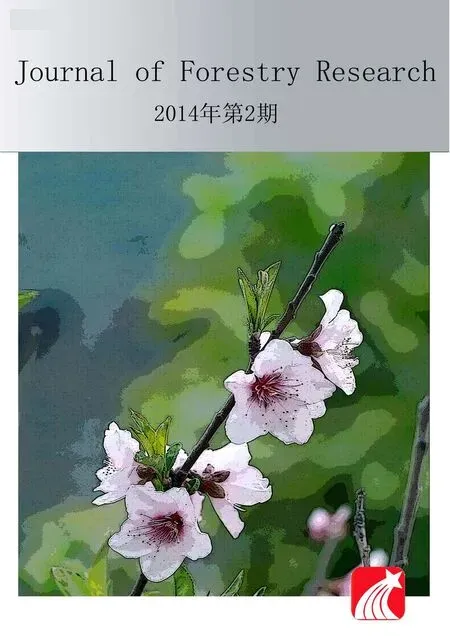 Journal of Forestry Research2014年2期
Journal of Forestry Research2014年2期
- Journal of Forestry Research的其它文章
- Compatibility and complementarity of indigenous and scientific knowledge of wild plants in the highlands of southwest Saudi Arabia
- Carbon sequestration in Chir-Pine (Pinus roxburghii Sarg.) forests under various disturbance levels in Kumaun Central Himalaya
- Genetic variability and divergence studies in pod and seed traits of Pongamia pinnata (L.) Pierre., accessions in Bay Islands
- Spatial distributions of tropical tree species in northern Vietnam under environmentally variable site conditions
- Goal programming approach for sustainable forest management (case study in Iranian Caspian forests)
- Effect of seed mass on emergence and seedling development in Pterocarpus marsupium Roxb.
